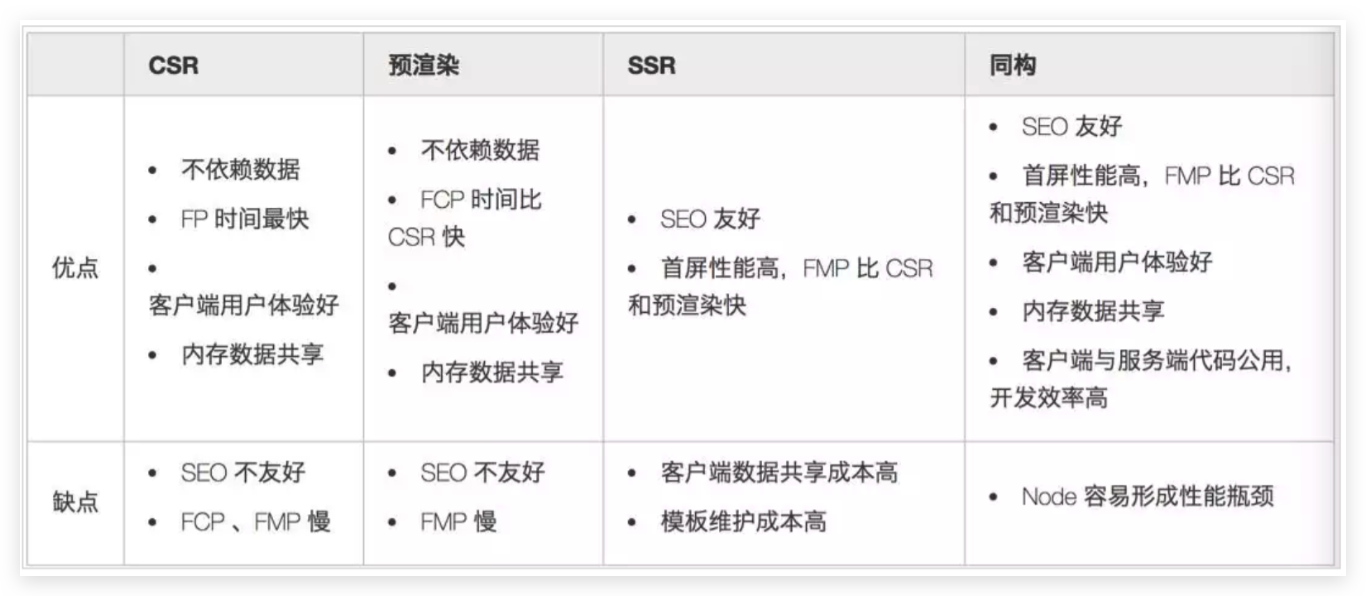NodeJS 服务端渲染
服务端渲染(SSR)#
目的:
- 解决SEO(由于搜索引擎爬虫抓取工具可以直接查看完全渲染的页面)
- 首屏白屏
最终效果:
- 刷新直出页面
- 切换路由走请求
关于同构#
比如:在服务端渲染 调用 React 的 服务端渲染方法 renderToString 但是无法绑定事件,我们需要在 里面再插入前端打包后的JS,我们需要将React代码在服务端执行一遍,在客户端再执行一遍,这种服务器端和客户端共用一套代码的方式就称之为同构。
实现(reaact为例)#
1. 首先服务端调用 renderToString 渲染组件#
import { renderToString } from 'react-dom/server'const ele = renderToString( <StaticRouter location={req.url} context={context}> <Fragment>{renderRoutes(routers)}</Fragment> </StaticRouter>)
const html = `<!DOCTYPE html> <html lang="en"> <head> ... </head>
<body> <div id="root">${ele}</div> <script src="/index.js"></script> </body> </html>`
// 再在 body 里面插入 打包后的 JS2. 路由#
在客户端我们可以使用 BrowserRouter, 在服务端我们使用 StaticRouter
解决页面刷新后重定向的问题:
app.get('*', (req, res) => { ... <StaticRouter location={req.url} context={context}> ... </StaticRouter>})3. 加载css#
在服务端解析 CSS 解析使用 isomorphic-style-loader ,会有一个 _getCss 方法。
isomorphic-style-loader 提供了一个withStyles 高阶函数
import withStyles from 'isomorphic-style-loader/withStyles'export default withStyles(styles)(App)拼接CSS:
{/* 在服务器端 */}const css = new Set() // CSS for all rendered React componentsconst insertCss = (...styles) => styles.forEach(style => css.add(style._getCss()))<StyleContext.Provider value={{ insertCss }}> ...</StyleContext.Provider><!-- 把CSS 插入到 head --><html lang="en"> <head> <style>${[...css].join('')}</style> </head>
<body> <div id="root">${ele}</div> <script src="/index.js"></script> </body></html>{/* 在客户端 */}const insertCss = (...styles) => { const removeCss = styles.map(style => style._insertCss()) return () => removeCss.forEach(dispose => dispose())} <StyleContext.Provider value={{ insertCss }}> ... </StyleContext.Provider>
4. 使用redux#
服务端使用
{/* 每一次调用返回一个新的store,避免服务器端所有人都引用的同一个对象 */}export const getServerStore = (req) => { const middleWares = thunk.withExtraArgument(serverAxios(req)); return createStore( reducers, applyMiddleware(middleWares) )} {/* 使用 Provider 进行连接 */}<Provider store={getServerStore(req)}> <StaticRouter location={req.url} context={context}> <Fragment>{renderRoutes(routers)}</Fragment> </StaticRouter></Provider>
- 客户端使用
```jsx export const getClienStore = () => { {/* 如果服务器端已经产生了数据,就作为默认store使用 也就是脱水操作 */} const defaultStore = window.REDUX_STORE || {}; return createStore( reducers, defaultStore, applyMiddleware(thunk.withExtraArgument(clientAxios)) ) } {/* 使用 Provider 进行连接 */} <Provider store={getClienStore()}> <BrowserRouter> <Fragment>{renderRoutes(routers)}</Fragment> </BrowserRouter> </Provider>5. 使用Axios#
这里使用到了 Node 作为中间件 转发数据,分为 client 和 server axios
client
import axios from 'axios'; const instance = axios.create({ baseURL: '/api',}); export default instance;server
import axios from 'axios'; const instance = req => axios.create({ baseURL: 'http://localhost:8085/api',}); export default instance;配置 http-proxy-middleware 转发
app.use('/api', createProxyMiddleware({ target: 'http://localhost:8085', changeOrigin: true }));router
react-router-config 提供了 matchRoutes 方法
const matchedRoutes = matchRoutes(routes, req.path);在需要数据预渲染路由添加 loadData 方法
{ path: '/home', key: 'home', exact: true, component: Home, loadData: Home.loadData},在服务端执行 loadData 方法
matchedRoutes.forEach(item => { if (item.route.loadData) { const promise = new Promise((resolve) => { item.route .loadData(store, item.match.params, req.query) .then(resolve) .catch(resolve); }); promises.push(promise); }}) // 数据全部渲染完 返回htmlPromise.all(promises).then(() => { const html = reder(store, req, res) res.send(html)})具体页面的操作
ExportHome.loadData = async store => { await store.dispatch(actions.getBlogList()) await store.dispatch(actions.getHotBlog()) await store.dispatch(actions.getTagList())}actions
export const getBlogList = (params = {}) => (dispatch, getState, axios) => axios.get('/blog/findAndCountAll', { params }).then(res => { dispatch(chanegState(constants.HOME_GETBLOGLIST, res.data.data))})
数据注水和数据脱水#
因为我们是 SSR 渲染,有些数据在服务端已经预先加载好,为了到客户端二次重新请求,就有了 注水 和 脱水的概念
注水
// 获取服务端的数据const store = getServerStore(req);// 注水const html = `<!DOCTYPE html> <html lang="en"> <head> ... </head> <body> <script> window.REDUX_STORE = ${JSON.stringify(store.getState())}; </script> <script src="/index.js"></script> </body> </html>`脱水
export const getClienStore = () => { // 如果服务器端已经产生了数据,就作为默认store使用 也就是脱水操作 const defaultStore = window.REDUX_STORE || {}; return createStore( reducers, defaultStore, applyMiddleware(thunk.withExtraArgument(clientAxios)) )}
其他#
使用 html-minifier 进行压缩#
对得到渲染后的 html 节点 进行压缩
import { minify } from 'html-minifier';
const minifyHtml = minify(html, { minifyCSS: true, minifyJS: true, minifyURLs: true,});使用 react-helmet 管理 head信息#
SEO 主要是针对搜索引擎进行优化,为了提高网站在搜索引擎中的自然排名,但搜索引擎只能爬取落地页内容(查看源代码时能够看到的内容),而不能爬取 js 内容,我们可以在服务器端做优化。
常规的 SEO 主要是优化:文字,链接,多媒体。
- 内部链接尽量保持相关性
- 外部链接尽可能多
- 多媒体尽量丰富 我们需要做的就是优化页面的 title,description 等,让爬虫爬到页面后能够展示的更加友好。
这里借助于 react-helmet 库,在服务期端进行 title,meta 等信息注入。
Node 启用 Gzip#
安装
npm install compression使用
var compression = require('compression')var app = express(); //尽量在其他中间件前使用compressionapp.use(compression());
一张图#
